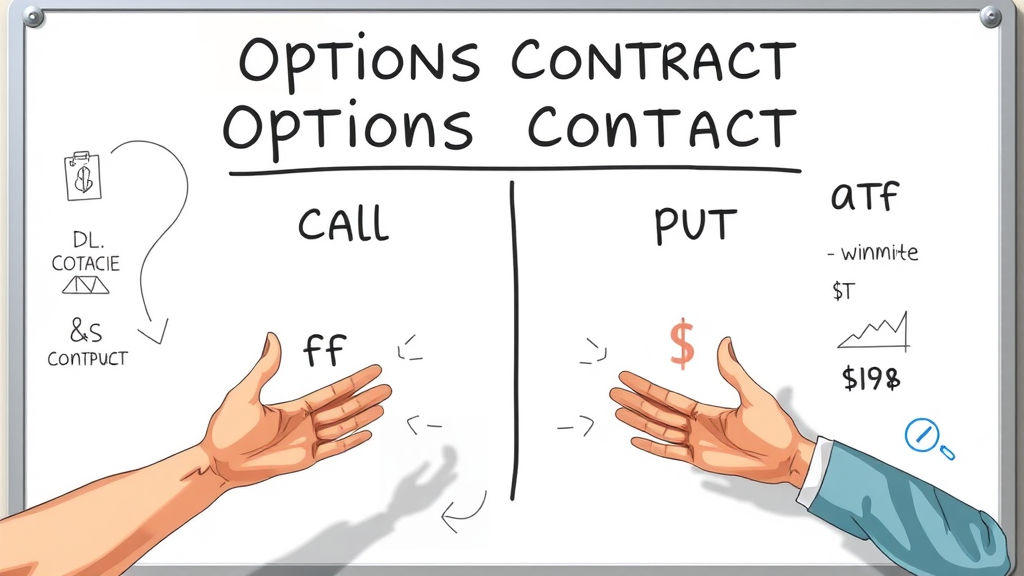"Did you know that over one billion options contracts are traded monthly in the US? Options trading has truly revolutionized modern investing, offering both risk management tools and profit opportunities to traders of all levels."

Curious about how modern investors generate impressive profits and hedge against risks? It could be as simple as understanding one powerful tool: trade options . Imagine a financial instrument that allows you to profit whether markets rise or fall—this is the promise of options trading . With monthly options contracts trading volumes crossing the one billion mark, learning what are trade options is no longer just for Wall Street pros. Whether you’re looking to diversify, boost returns, or manage downside effectively, this guide will walk you through the essentials of options trading. Let’s dive in and explore how you can start unlocking your financial potential today.
Understanding What Are Trade Options: Essentials Every Investor Should Know
-
Gain a comprehensive understanding of what are trade options and options contracts
-
Explore the basic mechanics of options trading and how profits are generated
-
Learn the distinctions between call options and put options
-
Analyze the significance of the strike price and the underlying assets
-
Discover common options strategies for profit and risk management
-
Assess the risks and rewards unique to modern options trade

At its core, trade options empower investors to buy or sell a specific asset, such as stocks, ETFs, or commodities, at a predetermined price and within a specified period of time. This flexibility equips traders and investors with the ability to profit from market swings or to protect portfolios against adverse movements. Options contracts are standardized agreements that grant this right, but not the obligation, to transact at a set strike price before the contract's expiration date. The beauty of options trading lies in its adaptability, enabling the use of strategies tailored for both bullish and bearish market conditions.
The two primary types of options are the call option and the put option . A call option allows the buyer to purchase the underlying asset, while a put option grants the right to sell the underlying asset at the strike price. These features make trade options indispensable for speculation, income generation, and hedging risk in any investment portfolio. As you move through this guide, you'll learn the strategic roles of each component, including how the strike price, premium, and underlying asset drive your options trading decisions.
Options Trading Explained: What Are Trade Options and Why Are They Popular?
The Appeal of Options Trading: Flexibility and Profit Potential

Options trading has soared in popularity due to its unrivaled flexibility and profit potential. Unlike traditional stock investing, where ownership is absolute, trading options lets investors speculate on market directions or safeguard existing holdings with limited upfront capital. An appealing aspect of trade options is leverage—small moves in the underlying asset can result in significant percentage gains (or losses). This feature enables traders to maximize returns or apply hedging techniques that minimize exposure to adverse price movements.
Another reason options trading stands out is the ability to customize strategies for nearly any market outlook. Whether markets are trending up, crashing down, or remaining flat, specialized options strategies —like covered calls or protective puts—can generate income, limit risk of loss, or simply amplify gains. By understanding the fundamentals of what are trade options, investors open themselves to robust methods for creating wealth and managing uncertainty in dynamic markets.
Core Features: Options Contract Structure and Terminology
|
Term |
Definition |
Relevance |
|---|---|---|
|
Options Contract |
A legal agreement granting the right to buy or sell an underlying asset |
Foundation of options trading |
|
Strike Price |
The predefined price at which an asset can be bought or sold |
Determines profit or loss |
|
Expiration Date |
The final date on which an options contract can be exercised |
Timeframe for action |
|
Premium |
The cost to purchase an options contract |
Defines the initial investment |

Getting familiar with essential options trading terms boosts your confidence in evaluating trade options. An options contract details the underlying asset, strike price, expiration date, and the premium paid by the option holder. The strike price is the centerpiece, representing the specific price at which you can buy (call) or sell (put) the underlying asset before the contract expires. The expiration date marks the last opportunity to exercise your rights, making timing critical for every options trade. The premium is the up-front cost to buy an option, directly influencing your potential loss and required risk management.
Each component in the options contract structure interacts to dictate your profits, losses, and overall strategy. For example, a low premium may reduce your investment size but can also imply a higher risk of the option expiring worthless. Understanding how to balance the moving parts of options contracts —strike price, premium, and time to expiration—empowers you to make informed, profit-minded decisions.
Types of Options: Call Options, Put Options, and Options Contracts
Call Option Explained: Unlocking Upside Potential in Options Trading

A call option is the gateway for investors to capitalize on upward price moves in an underlying security. When you purchase a call option, you gain the right, but not the obligation, to buy the underlying asset at a predetermined strike price, within a defined period of time. If the market price rises above this strike price before expiration, you can exercise the option, buying the asset at a discount compared to the open market, or sell the option itself for profit.
What makes call options particularly attractive is their leverage, controlling a large position with a relatively low premium. Rather than committing substantial capital to buy shares outright, you control the same upside with a smaller investment, limiting your potential loss to the premium paid. This feature allows strategic traders to amplify gains while retaining risk management control, making call options a core component of sophisticated trading options approaches.
Put Option Uncovered: Hedging and Profiting from Declines
A put option empowers investors to benefit when asset values decline. When you buy a put option, you acquire the right to sell the underlying asset at the strike price within the contract period. This is invaluable for hedging portfolios—if you hold a stock and the price plummets, a well-timed put can offset some or all of your loss. On the flip side, traders can speculate on market downturns and profit by purchasing puts, with their total exposure limited to the initial premium.
This distinctive approach is what makes put options an essential tool for both defensive and offensive strategies. Whether you anticipate a pullback in a specific stock or wish to safeguard gains during volatile markets, understanding how to properly utilize put options can mean the difference between enduring losses and even profiting in challenging times.
Comparing Call Options vs. Put Options: Choosing the Right Options Contract
-
Call Option: Right to buy the underlying asset at the strike price
-
Put Option: Right to sell the underlying asset at the strike price
-
Underlying Asset: Stocks, ETFs, indices, or commodities

Deciding between a call and a put option boils down to your market outlook. If you predict a rally in the underlying asset , a call option lets you profit from the upside with limited downside. Conversely, when expecting losses or seeking insurance for your holdings, a put option is your go-to tool. Both offer unique ways to execute options strategies suited to diverse market conditions, with flexibility for speculative or risk management goals.
Additionally, the versatility of options contracts enables you to engage a variety of underlying assets , ranging from blue-chip stocks to broad market indices and even commodities. This diversity lets you tailor your approach, trading options on assets that best align with your analysis and risk tolerance.
The Role of Underlying Asset and Strike Price in Options Trading
Decoding the Underlying Asset: Foundation of Options Contracts

Every options contract derives its value from an underlying asset —typically a stock, ETF, index, or even a commodity. This asset forms the core of your investment thesis, as its price movement directly determines whether your options trade is profitable. The selection of the right underlying asset is a critical first step; thorough research ensures that your market predictions align with the instrument you’re trading.
The flexibility of underlying assets in options trading means you’re not limited to equities. For example, you can trade options for gold, oil, or index funds, each carrying its own volatility profile and risk/reward dynamics. Knowing your asset inside-out helps you better forecast its price action and select the optimal options contract structure to capitalize on expected market trends.
Strike Price Significance: Maximizing Profit on Each Options Trade
|
Scenario |
Outcome |
|---|---|
|
Stock price rises above the strike price (Call Option) |
Potential for profit |
|
Stock price falls below the strike price (Put Option) |
Potential for profit |
|
Stock price equals strike price at expiry |
Option expires worthless |

The strike price is arguably the most influential element in any options trade. It’s the specific price at which you have the right to buy or sell the underlying security. The relationship between the price of the underlying asset and the strike price at expiration determines whether your trade ends in profit, a break-even, or a loss. For instance, a call option is only profitable if the market price exceeds the strike price plus the premium paid before expiration.
Selecting the right strike price depends on your risk-reward profile and view of the underlying asset’s volatility. Aggressive traders might choose strike prices far from the current market level (out-of-the-money options), banking on dramatic moves. More conservative investors usually select strike prices closer to the current price, providing a greater chance of expiring in the money, but at a higher premium. Mastering strike price selection is key to effective options trading and maximizing profit potential.
"Options offer a world of possibilities for tailoring your investment—learn the significance of the underlying asset and strike price to unlock new profit avenues."
How to Trade Options: Step-by-Step Beginner’s Guide
Opening a Brokerage Account for Trading Options
The first step toward trading options is opening a specialized brokerage account . Unlike a regular stock account, options trading accounts require investors to undergo an approval process that assesses experience, investment objectives, and financial knowledge. Most online platforms guide you through this process with simple questionnaires and offer educational resources to help you get started safely.
After approval, it’s crucial to familiarize yourself with your broker’s trading interface. Explore the available tools, research resources, and educational content provided so you can confidently manage your options contracts. This foundation ensures you’re equipped to enter the world of options trading armed with practical knowledge and the ability to make timely, informed decisions.
How to Buy or Sell Call Options and Put Options

Once your brokerage account is ready, you can buy or sell options contracts. To buy a call or put option, locate the desired underlying asset, select the strike price and expiration date, review the premium, and submit your order. Selling options is a more advanced strategy and involves higher risk, but can generate immediate income through the collection of premiums.
Profitable options trading involves careful selection of both the type of option—call or put—and the terms of the contract. Pay careful attention to the underlying stock’s trends, current price, and historical volatility before initiating an options trade. Always keep in mind your risk tolerance: while buying options caps your losses at the premium paid, selling options can result in higher exposure if the contract moves against you.
Understanding Options Premiums and Setting Trading Goals
The premium is the price you pay to acquire an options contract. It’s vital to understand how premiums fluctuate based on volatility, time to expiration, and the underlying asset’s current price. Before placing an options trade, estimate the returns required to justify your risk and decide in advance how much premium you’re willing to risk per contract.
Setting clear trading goals is essential. Are you aiming to generate income, speculate on short-term movements, or hedge existing positions? Your objective influences whether you choose call options, put options, or more advanced combinations. Always establish your exit criteria—such as profit targets or stop losses—so you remain disciplined and prepared for any market scenario.
Placing Your First Options Trade: Practical Example
Imagine you believe a company’s stock, now priced at $50, will climb in the next month. You buy a call option with a $55 strike price, expiring in 30 days, and pay a $2 premium. If the stock rallies above $57 before expiration, your profit is the share price minus the sum of the strike price and premium ($57 - $55 - $2 = $0). If the price stays flat or drops, your loss is limited to the premium paid.
Practice with virtual trading tools or small contracts to build experience before scaling up your trades. This hands-on approach builds confidence, hones your strategy, and helps you understand how real trades unfold in dynamic markets.
Popular Options Strategies for Profits and Risk Management
Simple Options Strategies: Covered Call and Protective Put

The covered call is a conservative approach for generating extra income from stocks you already own. By selling a call option against your holdings, you collect the premium but may be required to sell the underlying stock if its price rises above the strike price. This strategy is especially useful in flat to mildly bullish markets, offering steady returns with manageable risk.
The protective put acts as insurance for your investments. By purchasing a put option on a stock you hold, you secure the right to sell at the strike price if the market drops, limiting your potential loss but still allowing for upside if the price increases. These straightforward option strategies are ideal starting points for beginners learning to manage risk with disciplined, systematic methods.
Advanced Options Trading Strategies: Spreads and Combinations
-
Covered Call: Conservative income-generating strategy
-
Protective Put: Hedging downside risk
-
Straddle: Profiting from expected volatility
As your confidence grows, you can progress to advanced options strategies such as spreads (buying and selling multiple contracts at different strike prices) or combinations (merging calls and puts to profit from volatility or neutral conditions). These methods maximize reward, reduce risk, or both—but also demand increased knowledge and vigilance. Whether you choose vertical spreads for directional bets or straddles for uncertain markets, the flexibility of options trading ensures there’s a tactic for every scenario.
It’s wise to learn these advanced techniques systematically and practice in a risk-free environment before deploying capital. Effective use of advanced options strategies amplifies your profit opportunities while maintaining control over your risk of loss.
Risks and Rewards: What to Consider With Trade Options
Inherent Risks of Options Trading and How to Mitigate Them

All rewards in options trading come with associated risks. The potential to generate outsized returns is counterbalanced by the risk of losing your entire premium or, in the case of selling uncovered options, facing theoretically unlimited losses. Time decay—where the option loses value as it approaches the expiration date—can quickly erode your investment, especially with out-of-the-money contracts.
To mitigate these risks, always diversify your trades, limit your position sizes relative to your account, and utilize stop-loss or exit strategies. Education is your strongest defense—invest in learning about different types of options, practice with virtual accounts, and keep up-to-date with market conditions. Proper risk management is the lifeblood of success in options trading.
Balancing Risk and Reward in Each Options Contract
|
Risk |
Mitigation |
|---|---|
|
Option Expiry |
Set reminders and exit before expiry |
|
Premium Loss |
Use proven trading options strategies |
|
Market Volatility |
Focus on risk management plans |
A successful options trader strikes a balance between risk and reward by consistently applying proven strategies and leveraging proper risk controls. For every options contract, set clear guidelines on maximum acceptable loss, track key metrics (like implied volatility and open interest), and don’t allow emotions to override your trading plan. Remember, the flexibility and reward of options trading shine when paired with diligent discipline.
People Also Ask: Expert Answers to Top Questions on What Are Trade Options
How do trading options work?
-
Options trading involves buying or selling contracts that give the holder the right (not the obligation) to buy or sell an underlying asset at a specified strike price within a certain timeframe. Profits depend on accurate market forecasting and strategic contract management.
What is an example of option trading?
-
For example, if an investor expects a company’s stock to rise, they might purchase a call option with a strike price of $50, expiring in a month. If the stock price rises above $50, the investor may profit from the difference minus the premium paid.
Can you trade options with $100?
-
Absolutely. Many brokerage platforms allow users to start trading options with as little as $100, although starting small limits position size and potential returns.
Is trading options a good idea?
-
Trading options can be a good idea for individuals seeking unique strategies for profit and risk management. However, options trading involves higher risk than traditional investing, so education and disciplined strategies are critical.
Frequently Asked Questions About Options Trading and Trade Options
-
Can options trading be done in an IRA?
-
What are American vs. European options contracts?
-
Is trading options riskier than trading stocks?
-
What is a covered call in options trading?
-
How are options contracts taxed?
Key Insights to Guide Your Next Options Contract
-
Trade options offer versatility in financial markets, enabling profit from bullish, bearish, or neutral scenarios
-
Understanding strike price, underlying asset, and contract expiration is crucial to maximizing success
-
Advanced options trading strategies can further optimize the risk/reward balance
Empowering Your Financial Journey: Start Harnessing Options Trading Today
"Knowledge is your best investment. With the right understanding of what are trade options, your financial future can be reshaped one contract at a time."
Ready to unlock the power of options trading? Deepen your education, practice with small trades, and develop a disciplined approach—profit, protection, and empowerment await!
 Add Row
Add Row  Add
Add 




Write A Comment